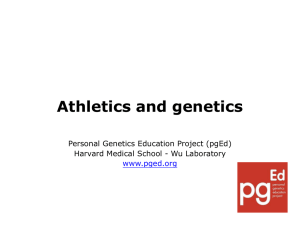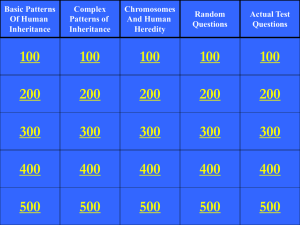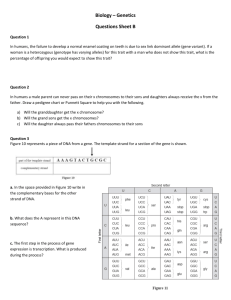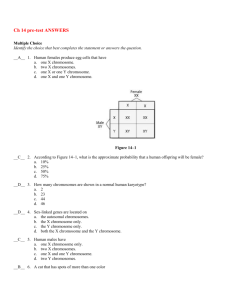Genetics in Everyday Life
advertisement
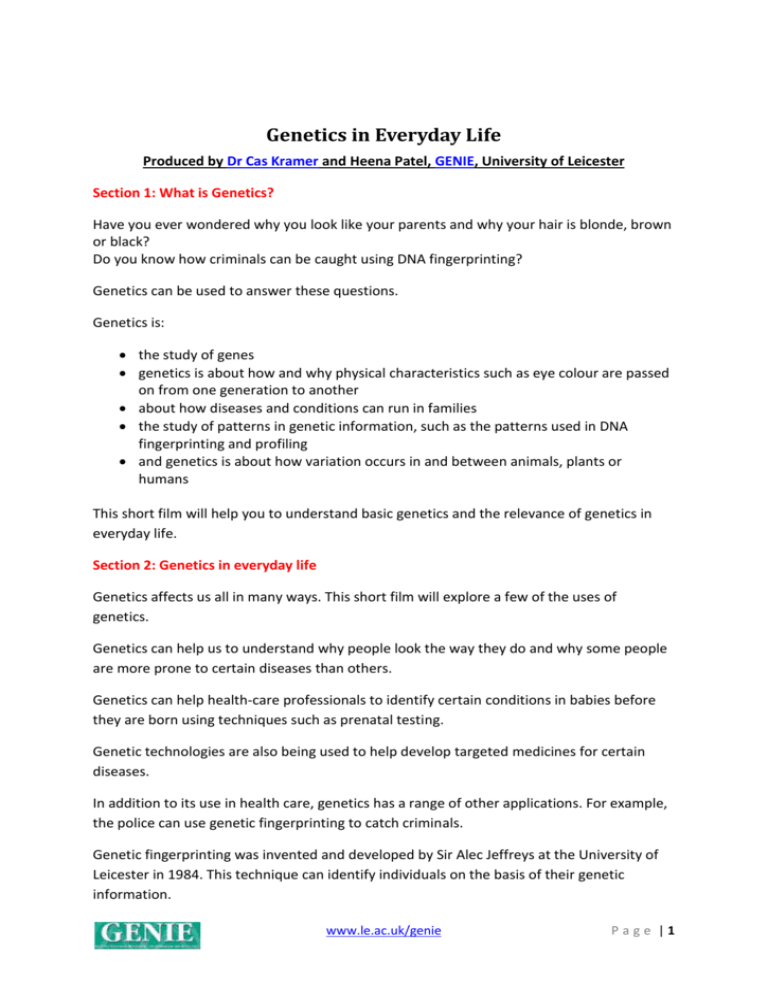
Genetics in Everyday Life Produced by Dr Cas Kramer and Heena Patel, GENIE, University of Leicester Section 1: What is Genetics? Have you ever wondered why you look like your parents and why your hair is blonde, brown or black? Do you know how criminals can be caught using DNA fingerprinting? Genetics can be used to answer these questions. Genetics is: the study of genes genetics is about how and why physical characteristics such as eye colour are passed on from one generation to another about how diseases and conditions can run in families the study of patterns in genetic information, such as the patterns used in DNA fingerprinting and profiling and genetics is about how variation occurs in and between animals, plants or humans This short film will help you to understand basic genetics and the relevance of genetics in everyday life. Section 2: Genetics in everyday life Genetics affects us all in many ways. This short film will explore a few of the uses of genetics. Genetics can help us to understand why people look the way they do and why some people are more prone to certain diseases than others. Genetics can help health-care professionals to identify certain conditions in babies before they are born using techniques such as prenatal testing. Genetic technologies are also being used to help develop targeted medicines for certain diseases. In addition to its use in health care, genetics has a range of other applications. For example, the police can use genetic fingerprinting to catch criminals. Genetic fingerprinting was invented and developed by Sir Alec Jeffreys at the University of Leicester in 1984. This technique can identify individuals on the basis of their genetic information. www.le.ac.uk/genie Page |1 Criminals often leave evidence of their identity at a crime scene: for example, hair follicles, blood or skin cells. The police can use the genetic information to demonstrate whether or not an individual was present at the scene of a crime. Genetic information can prove innocence and help to identify and convict the guilty. Section 3: Important concepts To understand genetics, it is important to know something about cells, chromosomes and DNA. All living things are made up of cells. The cell is the basic building block of life. A human body contains millions and millions of cells. An average adult has an estimated ten to one hundred thousand million cells. Each cell is so small that you can only see it using a microscope. There are many different types of cells, and they all have a different job to do. For example, the human body contains muscle cells, blood cells and skin cells. We can use a computer animation to show you what it is like inside a human cell. The nucleus is a very important component of the cell. It is the control centre and contains all your genetic information in the form of structures called chromosomes. Chromosomes carry information about you. For example, whether you have straight or curly hair, how your heart functions, and even which hand you write with. Chromosomes help to keep your genetic information neat, organised and compact, in much the same way that a filing cabinet can be used to organise paperwork. Chromosomes are made up of long strands of a chemical called deoxyribonucleic acid – or DNA for short. DNA contains four building blocks called adenine, thymine, cytosine and guanine. These are often referred to by their initial letters – A, T, C and G – and form long sequences that represent your unique genetic code. DNA consists of two ribbon-like strands that wrap around each other like a twisted ladder. This structure is described as a double helix. Part of the genetic information in the DNA is organised into thousands of specific coded instructions called genes. It is these genes that contain all the information needed to make you who you are. www.le.ac.uk/genie Page |2 Section 4: Inheritance In order to find out how characteristics are passed on from generation to generation, it is important to know something about basic inheritance. First we will focus on chromosomes. In every cell of your body there are 46 chromosomes in the form of 23 pairs. Each pair of chromosomes contains one chromosome inherited from your mother and one chromosome inherited from your father. This is why you may look like both of your parents. The 23 chromosomes from the father join the 23 chromosomes from the mother when the sperm joins the egg at the moment of conception. Each chromosome pair looks identical apart from the 23rd pair. This pair of chromosomes is known as the sex chromosomes, as they determine the sex of an individual. There are two sex chromosomes: the X chromosome and the Y chromosome. If you are female you will have two copies of the X chromosome. If you are male you have one copy of the X chromosome and one copy of the Y chromosome. A mother always passes on one of her X chromosomes to her children. The father can pass on an X chromosome or a Y chromosome. If the father passes on a Y chromosome the child will be male. If the father passes on an X chromosome the child will be female. In this random process, it is the male that determines the sex of the child as he can pass on either an X or a Y chromosome. Characteristics can be due to our genetic make-up and may be controlled by only one gene or by many genes. Many characteristics can be due to a combination of genetic and environmental factors like diet and exercise. Section 5: Patterns of Inheritance There are three main patterns in which characteristics are passed down from generation to generation: – Recessive Inheritance www.le.ac.uk/genie Page |3 – Dominant Inheritance and – X-linked Inheritance All of us have two copies of each gene; one copy is inherited from our mother and the other from our father. The only exception to this rule is the genes on the sex chromosomes. In this section, we will represent a chromosome like this: and a gene as a coloured dot The two copies – or variants - of each gene may be exactly the same or slightly different. In recessive inheritance, you develop a certain characteristic only if you possess two copies of a given variant of the gene concerned. For example, albinism is an inherited recessive condition that not only affects humans but many other animals – including tigers. In this condition, reduced amounts of a pigment called melanin are produced. In these individuals, both copies of a gene that plays a role in melanin production are not working properly. Using this animation, you can see how recessive inheritance works. Here, both parents carry the same non-working gene, as indicated by the light blue dot. However, as they have only one non-working gene, and the other gene is working properly, they are not affected by the condition and are known as ‘carriers’. What will happen when these parents pass on their genes to their children? It may be that both pass on their working gene to the child. The child will then have two working copies and will neither suffer from nor carry the condition. It may be that both pass on their non-working gene, in which case the child will have the condition. It may be that one parent passes on a working gene and the other passes on a non-working gene. In this case the child will not be affected, but he or she will be a carrier … just like the parents. Every one of these four combinations is equally likely every time a pregnancy occurs. Other examples of recessive inheritance include attached earlobes, thalassaemia and cystic fibrosis. www.le.ac.uk/genie Page |4 In dominant inheritance, you develop a certain characteristic, if you inherit one copy of a non-working gene, regardless of what the other copy is. Examples of dominant traits or conditions include brown eyes, black hair, Huntington Disease and Hereditary Breast Cancer. Marfan Syndrome is a medical condition that follows a dominant inheritance pattern. Individuals with this condition are usually taller than average and can develop problems with their hearts, bones and eyes. Using this animation, you can see how dominant inheritance works. Here is a father who has Marfan Syndrome and a mother who does not. If the non- working gene is passed on from the father, the child will be affected by this condition. If both the father and the mother pass on their working genes, the child will not be affected by this condition. As you can see, on average, half of the children will inherit the syndrome and half of the children will not. Every one of these four combinations is equally likely every time a pregnancy occurs. X-linked inheritance is associated with genes on the X chromosome, which is one of the two sex chromosomes. An example of an X-linked condition is haemophilia. In an individual with this condition the blood does not clot properly. Using this animation, you can see how X- Linked recessive inheritance works. Here the mother has one working copy of the gene and one non-working copy of the gene. She does not have haemophilia but she is a carrier of the condition. The father is not affected as he has one working copy of the gene. What will happen when these parents pass on their genes to their children? The mother could pass on her working gene. This will result in either a non- affected daughter or a non-affected son. Or the mother could pass on her non-working gene. This will result in either a daughter who is a carrier or an affected son. www.le.ac.uk/genie Page |5 A famous example of the X-linked inheritance of haemophilia can be seen in the extended family of Queen Victoria. She was a carrier, and a number of her children and grandchildren were either affected by the condition or carriers themselves. Other examples of X-linked conditions include red-green colour blindness and fragile Xsyndrome. Section 6: Genetic Conditions There are many genetic conditions and they can affect all parts of the body. Here we will outline some of the most common genetic conditions. Thalassaemia is a recessive condition that affects the blood. Individuals with this condition do not produce enough red blood cells and so find it difficult to transport oxygen around their bodies. Thalassaemia can affect individuals from any ethnic group, but it is especially common in people from Mediterranean countries, such as Italy and Malta, as well as India, Pakistan, the Middle East, and South-East Asia. Genetics allows us to understand how thalassaemia is passed on in families. Blood tests and genetic investigations can help us to determine whether an individual has the disease or is a carrier. Our improved understanding of the causes of the condition may even raise the possibility of future gene-based therapies that may offer a cure. Cystic fibrosis is the most common genetic condition in White Europeans. It affects the cells that produce mucus, sweat, saliva and digestive fluids. These secretions are normally thin and slippery, but in cystic fibrosis they are thicker and stickier. This makes it difficult for important organs such as the lungs and the digestive system to work properly, making it harder to breathe. Modern genetics can help parents with a family history of the disease to understand their risk of passing it on to their children, and provide tests that can identify the condition in babies before they are born. Section 7: Clinical Genetic Services If you feel that a referral to the genetics team is appropriate, please talk to your GP or Hospital Consultant about visiting your local clinical genetic service. www.le.ac.uk/genie Page |6 This service, based at a hospital, aims to help those affected by, or at risk of, a genetic condition. The team provides information, support and where necessary, can carry out appropriate investigations. Reasons for being referred include: • A genetic condition in the family • A strong family history of cancer, or • A delay in the development of a child that may have a genetic cause. Section 8: Further information We hope you have found this short introduction informative and enjoyable, and we hope that you now have an improved understanding of how useful genetics can be in our everyday lives. www.le.ac.uk/genie www.le.ac.uk/genie Page |7




